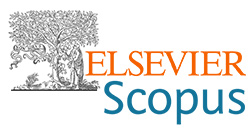Adsorption and anti-corrosion properties od cuttingfluids for shear blades of glass-forming machines
DOI:
https://doi.org/10.62638/ZasMat1225Abstract
The article presents the studies on the adsorption of water-miscible oil-containing cutting fluids on the R6M5 high-speed steel surface. The fluids can be used for the shear blades of drop feeders in glass-forming machines. The dependence of the anti-corrosion and lubricating properties of cutting fluids on their adsorption on steel surfaces is determined. The survey shows the serial G-417 cutting fluid achieves the highest adsorption value and anti-corrosion effect at a volumetric dilution of 1:4000, compared to the experimental cutting fluid based on G-417 at 1:1500. Based on the tests of the experimental cutting fluid at a glass factory, the experimental lubricant has greater operating dilution (1:1300) compared to the G-417 (1:800) at the same initial oil content. The higher lubricity of the new cutting fluid can be explained by the position of the adsorption maximum for the experimental mixture. The research formulates a necessary condition for improved operating characteristics, lubricity, and anti-corrosion properties of a cutting fluid by the selection of emulsifiers and functional additives for the cutting fluid: the proximity of the concentrations for maximum adsorption capacity and operating dilution ranges (1:800 - 1:2000). Electrochemical studies show that both the G-417 and experimental lubricant have anodic mechanism of corrosion inhibition
Keywords:
Adsorption, cutting fluid, anti-corrosion effect, surface tension, wetting, polarization curvesReferences
Total Kleenmold Lubricants, http://industerro.nl/pdf/ Kleenmold-products.pdf (February 2, 2024)
Acmos 46-10, https://henax.pl/acmos-46-10/?lang = =en (February 2, 2024)
VITROLIS Lubricants for Glass Manufacturing Industries, https://www.tempos.bg/GLAS%20 Brochure%20VITROLIS%20EN.pdf (February 2, 2024)
SHEAR BLADE LUBRICANT Gelltex-425, https://en.nppsintez.com/product/products-for-glass-container-manufacture/smazka-dlya-lezvij-nozhnic-stekloformiruyushchih-mashin-gelltex-425/
V. Deshpande, P. N. Jyothi (2022) A review on sustainable eco-friendly cutting fluids, Journal of Sustainability and Environmental Management, 1(2), 306-320. https://doi.org/10.3126/josem. v1i2. 45383
M. Naveed, A. Arslan, H. M. A. Javed, T. Manzoor, M. M. Quazi, T. Imran, Z. M. Zulfattah, M. Khurram, I. M. R. Fattah (2021) State-of-the-art and future perspectives of environmentally friendly machining using biodegradable cutting fluids, Energies, 14(16), 4816. https://doi.org/10.3390/en14164816
P. Kumar, A. K. Jain, P. K. Chaurasiya, D. Tiwari, A. Gopalan, J. Arockia Dhanraj, J. Muthiya Solomon, A. Sivakumar, K. Velmurugan, J. Fefeh Rushman (2022) Sustainable machining using eco-friendly cutting fluids: A review, Adv. Mater. Sci. Eng., 2022.
VITROLIS SHEARLUBE 722X, https://www.fuchs.com/es/en/product/product/24295-VITROLIS-SHEARLUBE-722X/ (February 2, 2024)
R. Conradt (2008) The industrial glass-melting process, In The SGTE Casebook (pp. 282-303), Woodhead Publishing. https://doi.org/10.1533/ 9781845693954.2.282
A. Farina, A. Klar, R. M. Mattheij, N. Siedow (2010) Mathematical models in the manufacturing of glass: CIME Summer School, Montecatini Terme, Italy 2008. Springer.
S. Tekumalla, R. Tosi, X. Tan, M. Seita (2022) Directed energy deposition and characterization of high‐speed steels with high vanadium content, Addit. Manuf. Lett., 2, 100029. https://doi.org/ 10.1016/j.addlet.2022.100029
I. Peruš, H. Palkowski, G. Kugler, M. Terčelj (2020) Quantifying complex influences of chemical composition and soaking conditions for increasing the hot workability of M2 high-speed steel by using the alternative approach, J. Mater. Res. Technol., 9(6), 13301-13311. https://doi.org/10.1016/j.jmrt. 2020.09.029
L. A. Dobrzański (1995) Effects of chemical composition and processing conditions on the structure and properties of high-speed steels. J. Mater. Process. Technol., 48(1-4), 727-737. https://doi.org/10.1016/0924-0136(94)01715-d
H. Li, Y. Zhang, C. Li, Z. Zhou, X. Nie, Y. Chen, H. Cao, B. Liu, N. Zhang, Z. Said, S. Debnath, M. Jamil, H. M. Ali, S. Sharma (2022) Cutting fluid corrosion inhibitors from inorganic to organic: Progress and applications, Korean J. Chem. Eng., 39(5), 1107-1134. https://doi.org/10.1007/s11814-021-1057-0
S. E. Kaskah, M. Pfeiffer, H. Klock, H. Bergen, G. Ehrenhaft, P. Ferreira, J. Gollnick, C.B. Fischer (2017). Surface protection of low carbon steel with N-acyl sarcosine derivatives as green corrosion inhibitors, Surfaces and Interfaces, 9, 70-78. https://doi.org/10.1016/j.surfin.2017.08.002
SHEAR BLADE LUBRICANT Gelltex-417, https://en.nppsintez.com/product/products-for-glass-container-manufacture/smazka-dlya-lezvij-nozhnic-gelltex-417/ (February 2, 2024)
D. A. Ponomarev, M. P. Krasnovskikh, M. G. Shcherban, A. B. Shein, E. A. Salomasova (2023) Cutting fluids for the glass container industry: development, physicochemical and anti-corrosion properties, Int. J. Corros. Scale Inhib, 12(3), 867-877.https://doi.org/10.17675/2305-6894-2023-12-3-4
N. Ochoa, F. Moran, N. Pébère (2004) The syne-rgistic effect between phosphonocarboxylic acid salts and fatty amines for the corrosion protection of a carbon steel, J. Appl. Electrochem., 34, 487-493.https://doi.org/10.1023/b:jach.0000021702.49827. 11
R. Anton, F. Mosquera, M. Oduber (1995) Anionic-nonionic surfactant mixture to attain emulsion insensitivity to temperature, Trends in Colloid and Interface Science IX, 85-88. https://doi.org/ 10.1007/bfb0115213
Y. Zheng, E. A. Caicedo-Casso, C. R. Davis, J. A. Howarter, K. A. Erk, C. J. Martinez (2023) Impact of mixed surfactant composition on emulsion stability in saline environment: anionic and nonionic surfactants, J. Dispersion Sci. Technol., 44(7), 1103-1115. https://doi.org/10.1080/01932691. 2021. 1999255
Pendant drop, https://www.kruss-scientific.com/ en/know-how/glossary/pendant-drop (February 2, 2024)
J. Yang, J. Wu, S. Bi (2021) Surface tension measurements by pendant drop method of 10 pure long-chain alkanes and alcohols for temperatures up to 573.15 K, J. Chem. Eng. Data, 66(6), 2615-2628. https://doi.org/10.1021/acs.jced.1c00212
J. M. Schuster, C. E. Schvezov, M. R. Rosenberger (2015) Influence of experimental variables on the measure of contact angle in metals using the sessile drop method, Procedia Mater. Sci., 8, 742-751. https://doi.org/10.1016/j.mspro.2015.04.131
Yu. G. Bogdanova, V. D. Dolzhikova, B. D. Summ (2004) Vliyanie himicheskoj prirody komponentov na smachivayushchee dejstvie rastvorov smesej poverhnostno-aktivnyh veshchestv (The influence of the chemical nature of the components on the wetting effect of solutions of mixtures of surfactants), Vestnik Moskovskogo universiteta. Seriya 2. Himiya, 45(3), 186-194. (In Russian)
K. Szymczyk (2013) Wetting and Adsorption Properties of Aqueous Solutions of Ternary Mixtures of Hydrocarbon and Fluorocarbon Nonionic Surfactants in PTFE-Solution–Air Systems, Ind. Eng. Chem. Res., 52(26), 9106-9114. https://doi.org/10.1021/ie4003602
GOST 9.506-87 – 1988. Edinaya sistema zashchity ot korrozii i stareniya (ESZKS). Ingibitory korrozii metallov v vodno-neftyanyh sredah. Metody opredeleniya zashchitnoj sposobnosti (Unified system of protection against corrosion and aging (USZKS). Inhibitors of metal corrosion in water-oil environments. Methods for determining protective effect) (1993) Izdatel'stvo standartov, Moscow. (In Russian)
N. Azum, K. A. Alamry, S. B. Khan, M. A. Rub, A. M. Asiri, Y. Anwar (2016) Synergistic interaction between anionic and nonionic surfactant: Application of the mixed micelles templates for the synthesis of silver nanoparticles, Int. J. Electrochem. Sci., 11, 1852-1867. https://doi.org/10. 1016/s1452-3981(23)16066-4
M. Agneta, L. Zhaomin, Z. Chao, G. Gerald (2019) Investigating synergism and antagonism of binary mixed surfactants for foam efficiency optimization in high salinity. Journal of Petroleum Science and Engineering, 175, 489-494. https://doi.org/10.1016/ j.petrol.2018.12.074
O. Mosalman Haghighi, A. Mohsenatabar Firozjaii (2020) An experimental investigation into enhancing oil recovery using combination of new green surfactant with smart water in oil-wet carbonate reservoir, J. Pet. Explor. Prod. Technol., 10, 893-901. https://doi.org/10.1007/s13202-019-0741-7
F. Staniscia, H. V. Guzman, M. Kanduč (2022) Tuning contact angles of aqueous droplets on hydrophilic and hydrophobic surfaces by surfactants, The Journal of Physical Chemistry B, 126(17), 3374-3384. https://doi.org/10.1021/ acs.jpcb.2c01599.s001
S. R. Shadizadeh, M. Amirpour (2023) Reservoir rock wettability alteration using different types of surfactants: Experimental assessment, Energy Sources, Part A: Recovery, Utilization, and Environmental Effects, 45(1), 383-389. https://doi.org/10.1080/15567036.2016.1217291
Yu. I. Kuznetsov (2002) Sovremennoe sostoyanie teorii ingibirovaniya korrozii metallov (Current state of the theory of metal corrosion inhibition), Zashchita metallov, 38(2), 122-131. (In Russian)
A. F. S. A. Rahiman, S. Sethumanickam (2017) Corrosion inhibition, adsorption and thermodynamic properties of poly (vinyl alcohol-cysteine) in molar HCl. Arabian J. Chem., 10, S3358-S3366. https://doi.org/10.1016/j.arabjc.2014.01.016
I. A. Men'shikov, N. V. Luk'yanova, A. B. Shein (2019) Zashchita stali ot korrozii v kislyh sredah ingibitorami "SolIng" pri povyshennyh temperaturah (Corrosion protection of steel in acidic media using SolIng inhibitors at elevated temperatures) Izvestiya vysshih uchebnyh zavedenij. Himiya i himicheskaya tekhnologiya, 62(4), 103-110. (In Russian) https://doi.org/10.6060/ivkkt20186100.5724







